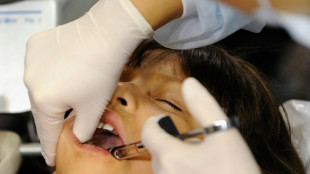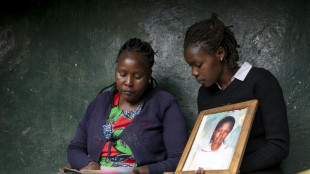
-
 New York City beat Charlotte 3-1 to advance in MLS Cup playoffs
New York City beat Charlotte 3-1 to advance in MLS Cup playoffs
-
'Almost every day': Japan battles spike in bear attacks

-
 MLS Revolution name Mitrovic as new head coach
MLS Revolution name Mitrovic as new head coach
-
Trump gives Hungary's Orban one-year Russia oil sanctions reprieve

-
 Owners of collapsed Dominican nightclub formally charged
Owners of collapsed Dominican nightclub formally charged
-
US accuses Iran in plot to kill Israeli ambassador in Mexico

-
 New Zealand 'Once Were Warriors' director Tamahori dies
New Zealand 'Once Were Warriors' director Tamahori dies
-
Hungary's Orban wins Russian oil sanctions exemption from Trump

-
 More than 1,000 flights cut in US shutdown fallout
More than 1,000 flights cut in US shutdown fallout
-
Turkey issues genocide arrest warrant against Netanyahu

-
 Countries agree to end mercury tooth fillings by 2034
Countries agree to end mercury tooth fillings by 2034
-
Hamilton faces stewards after more frustration

-
 World's tallest teen Rioux sets US college basketball mark
World's tallest teen Rioux sets US college basketball mark
-
Trump pardons three-time World Series champ Strawberry

-
 Worries over AI spending, US government shutdown pressure stocks
Worries over AI spending, US government shutdown pressure stocks
-
Verstappen suffers setback in push for fifth title

-
 Earth cannot 'sustain' intensive fossil fuel use, Lula tells COP30
Earth cannot 'sustain' intensive fossil fuel use, Lula tells COP30
-
Wales boss Tandy expects Rees-Zammit to make bench impact against the Pumas

-
 James Watson, Nobel prize-winning DNA pioneer, dead at 97
James Watson, Nobel prize-winning DNA pioneer, dead at 97
-
Medical all-clear after anti-Trump package opened at US base

-
 Sabalenka beats Anisimova in pulsating WTA Finals semi
Sabalenka beats Anisimova in pulsating WTA Finals semi
-
Iran unveils monument to ancient victory in show of post-war defiance

-
 MLS Revolution name Mitrovic as hew head coach
MLS Revolution name Mitrovic as hew head coach
-
Brazil court reaches majority to reject Bolsonaro appeal against jail term

-
 Norris grabs pole for Brazilian Grand Prix sprint race
Norris grabs pole for Brazilian Grand Prix sprint race
-
More than 1,200 flights cut across US in govt paralysis

-
 NFL Cowboys mourn death of defensive end Kneeland at 24
NFL Cowboys mourn death of defensive end Kneeland at 24
-
At COP30, nations target the jet set with luxury flight tax

-
 Trump hosts Hungary's Orban, eyes Russian oil sanctions carve-out
Trump hosts Hungary's Orban, eyes Russian oil sanctions carve-out
-
All Blacks 'on edge' to preserve unbeaten Scotland run, says Savea

-
 Alpine say Colapinto contract about talent not money
Alpine say Colapinto contract about talent not money
-
Return of centuries-old manuscripts key to France-Mexico talks

-
 Byrne adamant Fiji no longer overawed by England
Byrne adamant Fiji no longer overawed by England
-
Ex-footballer Barton guilty over 'grossly offensive' X posts

-
 Key nominees for the 2026 Grammy Awards
Key nominees for the 2026 Grammy Awards
-
Brazil court mulls Bolsonaro appeal against jail term

-
 Rybakina sinks Pegula to reach WTA Finals title match
Rybakina sinks Pegula to reach WTA Finals title match
-
Earth 'can no longer sustain' intensive fossil fuel use, Lula tells COP30

-
 Kendrick Lamar leads Grammy noms with nine
Kendrick Lamar leads Grammy noms with nine
-
Ex-British soldier fights extradition over Kenyan woman's murder

-
 Kolisi to hit Test century with his children watching
Kolisi to hit Test century with his children watching
-
Alex Marquez fastest in practice ahead of Portuguese MotoGP

-
 Will 'war profiteer' Norway come to Ukraine's financial rescue?
Will 'war profiteer' Norway come to Ukraine's financial rescue?
-
Tech selloff drags stocks down on AI bubble fears

-
 Blasts at Indonesia school mosque injure more than 50
Blasts at Indonesia school mosque injure more than 50
-
Contepomi says lead-in to Wales match a 'challenge' for Argentina

-
 Greece woos US energy deals, as eco groups cry foul
Greece woos US energy deals, as eco groups cry foul
-
Frank says Spurs supporting Udogie through 'terrible situation'

-
 MSF warns of missing civilians in Sudan's El-Fasher
MSF warns of missing civilians in Sudan's El-Fasher
-
Norris on top as McLaren dominate opening Sao Paulo practice


First 'concrete picture' of Neanderthal family revealed by DNA
The original Flintstones? The largest genetic study of Neanderthals ever conducted has offered an unprecedented snapshot of a family, including a father and his teenage daughter, who lived in a Siberian cave around 54,000 years ago.
The new research, published in the journal Nature on Wednesday, used DNA sequencing to look at the social life of a Neanderthal community, finding that women were more likely to stray from the cave than men.
Previous archaeological excavations have shown that Neanderthals were more sophisticated than once thought, burying their dead and making elaborate tools and ornaments.
However little is known about their family structure or how their society was organised.
The sequencing of the first Neanderthal genome in 2010, which won Swedish paleogeneticist Svante Paabo the medicine Nobel prize earlier this month, offered a new way to discover more about our long extinct forerunners.
An international team of researchers focused on multiple Neanderthal remains found in the Chagyrskaya and Okladnikov caves in southern Siberia.
The scattered fragments of bones were mostly in a single layer in the earth, suggesting the Neanderthals lived around the same time.
"First we had to identify how many individuals we had," Stephane Peyregne, an evolutionary geneticist at Germany's Max Planck Institute and one of the study's co-authors, told AFP.
- 'Seem much more human' -
The team used new techniques to extract and isolate the ancient DNA from the remains.
By sequencing the DNA, they established there were 13 Neanderthals, seven males and six females. Five of the group were children or early adolescents.
Eleven were from the Chagyrskaya cave, many of them from the same family including the father and his teenage daughter, as well as a young boy and a woman who were second-degree relatives, such as a cousin, aunt or grandmother.
The researchers also worked out that one man was a maternal relative of the father because he had a genetic phenomenon called heteroplasmy, which only passes down a couple of generations.
"Our study provides a concrete picture of what a Neandertal community may have looked like," Max Planck's Benjamin Peter, who supervised the research along with Paabo, said in a statement.
"It makes Neandertals seem much more human to me," he added.
Genetic analysis showed that the group did not interbreed with its nearby relatives such as humans and Denisovans, hominins discovered by Paabo in caves just a few hundred kilometres away.
However we know that Neanderthals did breed with homo sapiens at some point -- Paabo's research also revealed that almost all modern humans have a little Neanderthal DNA.
- Rampant inbreeding -
The community of around 10 to 20 Neanderthals seems to have instead bred largely among themselves, displaying very little genetic diversity, the study found.
Neanderthals existed between 430,000 to 40,000 years ago, so this group was living in the twilight of its species.
The study compared the community's level of inbreeding to endangered mountain gorillas. Another explanation for the inbreeding could be that the Neanderthals lived in an isolated region.
"We are probably dealing with a very subdivided population," Peyregne said.
The researchers found that the group's Y-chromosomes, which are inherited from father to son, were far less diverse than its mitochondrial DNA, which is inherited from mothers.
This suggests that the women travelled more frequently to interact and breed with different groups of Neanderthals, while the men largely stayed home.
Antoine Balzeau, a palaeoanthropologist at France's National Museum of Natural History, said that fossils found in the Sidron Cave in Spain prompted suggestions of a similar Neanderthal community there, but far less complete genetic material is available.
Balzeau, who was not involved in the latest study, said it was "a very interesting technical feat".
But "it will have to be compared with other groups" of Neanderthals, he added.
K.AbuTaha--SF-PST
